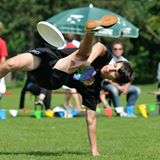The flamingitosis is one of the most challenging catches. To understand it, it helps to break down the name; Flamingo – Gitis – Osis. A flamingo is when one plants on one leg and catches the disc behind the planted leg. A gitis is a variation of under the leg where the disc is caught around the outside of the leg opposite the catching hand. So right hand catches on the outside of the left leg and vice versa. So, a flamingosis is catching around the outside of the planted leg with the opposite hand. An osis is when one spins away from the catch so body rotation moves the hand in the direction as the disc is flying. Check the links for more details on each. Now put it all together and you have a flamingitosis.
Of course Matt, being the incredible jammer that he is, decided to add a double spin before he caught it. This is not a requirement. To fully understand the body mechanics involved, watch the video. There’s even a nice slow motion section. After Matt’s second spin you can see how he looks over his catching shoulder for as long as he can before his body blocks the view. Watching the disc as long as possible is the key to making this catch.
Another thing I find helpful is falling into the catch. The fall is not required, but for me it opens the window just a little more. You can see in the video, it works for Matt as well.



